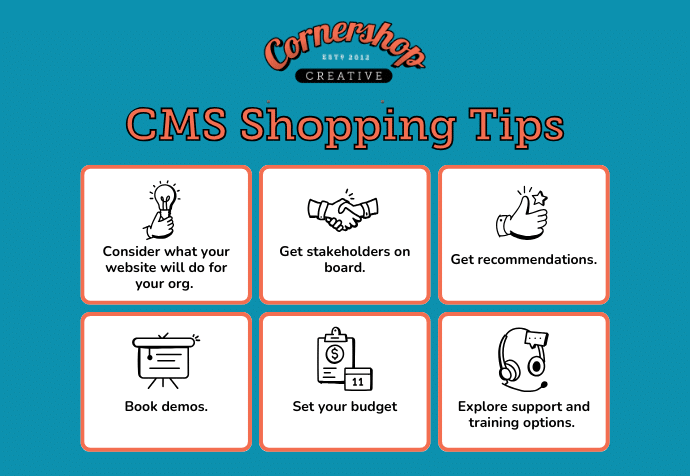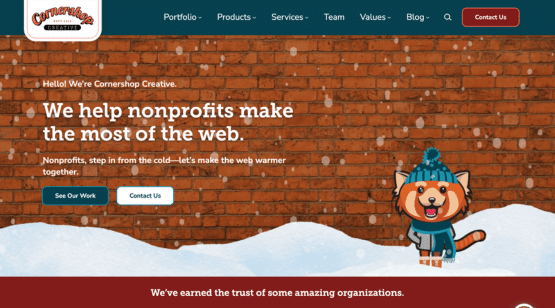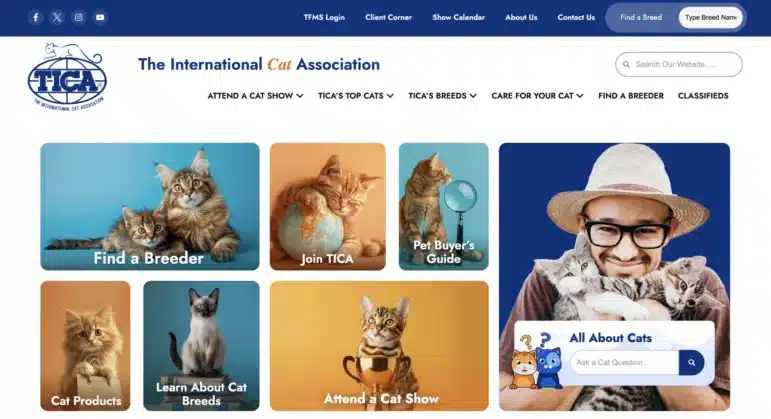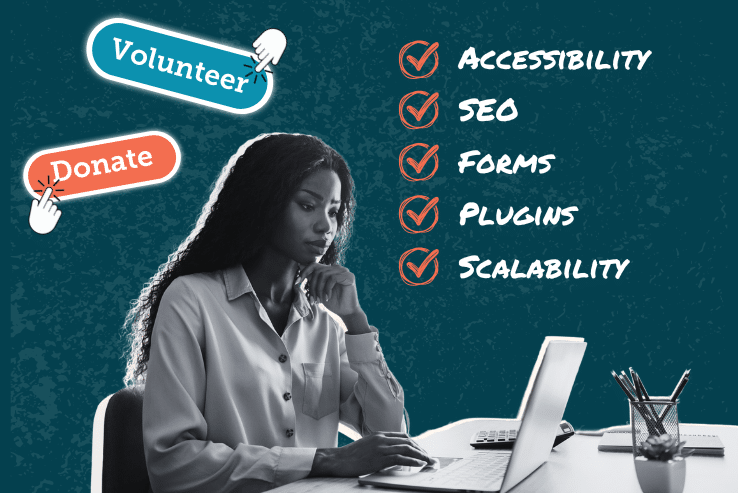Nowadays, a functional and engaging website is a must-have for every nonprofit. But what’s working behind the scenes to create a home for your content, engage users, and drive important actions like donating?
This magic happens through a powerful tool that makes websites manageable, scalable, and easy to update: a nonprofit content management system (CMS). You can think of a nonprofit CMS as the control center of a nonprofit website. Your CMS empowers you to set up an eye-catching visual design, organize content, track engagement, and more, all without needing a team of developers on standby every time you want to make a change to your site.
Whether you’re hoping to build your first nonprofit website or revamp your current one, choosing the right CMS can feel overwhelming. But it doesn’t have to be! This guide will walk you through everything you need to consider as you shop:
- Nonprofit CMS Basics
- Beginning the CMS Shopping Process: Quick Tips
- Creating Your Shopping List: Nonprofit CMS Features to Look For
- 7 Top CMS Providers to Consider for Your Organization
- Starting off on the Right Foot With Your New Nonprofit CMS
The key to finding the best CMS for your nonprofit is careful preparation and consideration of your needs. Let’s dive into the rest of the process so you can build the website of your dreams!
Partner with us for a custom-built WordPress website that drives engagement, boosts donations, and amplifies your mission!
Nonprofit CMS Basics
What is a nonprofit CMS?
A nonprofit content management system (CMS), also known as a nonprofit website builder, is a website design tool that allows organizations like yours to easily create and manage a website without needing advanced technical skills.
A nonprofit CMS is essential to your nonprofit’s technology stack and digital strategy. Because your website acts as the central hub of your organization’s online presence, having a tool to help you make your website as strong as possible will be essential to other parts of your digital operations, such as marketing and fundraising.
Different Options to Consider
As you research various nonprofit CMS providers, there are three core aspects of each tool you need to consider:
- Hosted vs. SaaS: A hosted CMS is one that is installed directly into your organization’s internal server. A software as a service (SaaS) CMS is a fully managed service, with the vendor handling all updates and maintenance of the platform while your nonprofit accesses it via a subscription, usually through a web browser. The main difference between the two is that a hosted CMS will require a little more technical footwork from your team but will provide more customization options for your website, while a SaaS CMS is typically more user-friendly but requires your organization to give up control of the tool to your vendor.
- Open Source Platform vs. Proprietary: An open-source CMS tool is one where the source code underlying the platform is open to the public and able to be modified by anyone (WordPress is an example of an open-source platform). Vendors who offer proprietary CMS tools do not allow the source code to be altered by the public. If your organization is more tech-savvy (or works with a tech-savvy web designer) and wants to make improvements to its CMS down the line, you may want to opt for an open-source platform. If you’d rather not touch the source code of your tool and leave development up to the vendor, a proprietary CMS may be the best choice.
- Nonprofit-Specific vs. Generic: Some CMS platforms are designed specifically for nonprofits, offering tools for handling donations, events, and volunteer management tasks. Plenty of popular and user-friendly “generic” options aren’t built specifically for nonprofits, but their functionality can easily be expanded to meet nonprofit needs through things like plugins or integrations.
Beginning the CMS Shopping Process: Quick Tips
Now that you know the basics of what a nonprofit CMS is, how it fits into your organization’s larger digital strategy, and some of the core characteristics you’ll need to consider when evaluating different platforms, it’s time to prepare for the shopping process!
Here are a few tips to help your organization get ready to find the best CMS for its needs:

- Consider what your website needs to do for your organization. For instance, maybe you want to use it to publish educational information about your cause to raise awareness of the issues your organization is working to solve and support your other digital marketing efforts. Or, perhaps you want it to be an easy-to-use tool for taking action, like making a donation or signing up to volunteer. There are likely several roles you want your website to fill, and outlining these needs beforehand can guide a successful CMS shopping experience. Whether this is your first website or not, you may find it helpful to explore other organizations’ websites to see how they make the most of these tools.
- Get stakeholders on board. A CMS and a new website will require an investment on your organization’s part. Ensure that all organizational stakeholders (including board members and leaders like your executive director) are on board with your plan to shop for a CMS. Align on what you want out of the tool, your budget, and the timeline for the shopping process and creating your new site.
- Set your budget. CMSs will vary widely in price. As you budget for a CMS, consider not only the features you feel are essential for your needs but also hidden costs such as hosting, working with a web designer, customization, and ongoing maintenance. This will ensure you choose a system within your financial means and prevent you from overspending on unnecessary tools or services.
- Get recommendations from trusted colleagues. Before any type of purchase, it can be helpful to talk to others about their experience with a product or service. Look at online reviews for the CMSs you’re considering and reach out to trusted colleagues in the nonprofit sector to ask about their experience with different platforms.
- Book demos. As with any type of software, it can be difficult to picture a CMS in action after reading about its features and functionality. Reach out to vendors to book demos where you can see how the CMS works in real time. Some tools may also offer free trials, allowing you to take them for a spin on your own.
- Explore support and training options. After purchasing or subscribing to a CMS, the last thing you want to have happen is to be left in the lurch trying to get it set up! As you go into the shopping experience, ensure you inquire about the level of support and training each vendor offers (and if there is any cost associated with getting that support). You don’t just have to rely on the vendor for help, either. Look into the community surrounding the CMS, too. For example, there are dozens of WordPress support services that can help your organization navigate the WordPress CMS, and there are tons of free online resources (like forums and training videos) available, too.
Creating Your Shopping List: Nonprofit CMS Features to Look For
We’ve all been there—you pull up to the grocery store ready to stock up for the week ahead and realize you’ve forgotten your grocery list (or worse, forgotten to write one out altogether!). Though you get through the shopping trip and get most of the things you need, the process likely isn’t as efficient as you wanted it to be. You may also find that you’ve spent more than you intended to (or bought one too many candy bars).
Long story short: Having a shopping list is important, especially when you start looking for a nonprofit CMS. It helps you stay focused, keeps your budget top of mind, and allows you to make the best choice for your organization’s needs.
Here are some features to include on your CMS shopping list:

- User-Friendliness: Your entire team, regardless of technical skill level, should be able to easily customize various website elements and manage and update website content. Also, the platform itself should be easy to set up.
- High Security Standards: Your website may handle sensitive organizational and donor data. Ensure that your chosen nonprofit CMS is built to comply with security regulations and prevent data breaches.
- Integration Opportunities: To prevent inefficiency and avoid data siloes, your entire technology stack needs to be connected so that all of your tools can work together. Look for a CMS that can integrate with other core tools like your constituent relationship management (CRM) system and marketing platforms.
- Plugins: Plugins are external tools you can add to your CMS to expand its functionality. For instance, you may want a plugin that makes it easier to manage your website’s media library, create donation forms, set up an event calendar, or build out your annual report. (A word to the wise: Always do thorough research on any plugin you’re considering downloading. Some plugins are scams or just don’t work. But there are hundreds of options out there that can enhance your website’s existing features.)
- Mobile-Responsiveness: Did you know that more than 60% of website traffic comes from mobile devices? Ensure your website is prepared to welcome visitors who access it on mobile phones and tablets by double-checking that it offers mobile responsiveness. Many platforms will automatically resize your content to fit any size screen your visitors are using, but it’s still worth looking into.
- Templates and Themes: Templates and themes empower you to quickly create a professional-looking website that is consistent with your organization’s branding. Check out the options offered by the CMSs you’re interested in so that you know the visual styles you have to work with before designing your site.
- Customizability: Beyond the basic visual look of your website, you’ll also want the power to tinker with its feel and front-end functionality. This will allow you to provide a smooth user experience that is consistent with your nonprofit’s digital goals.
- Multi-User Support: Platforms that allow multiple users to manage content with varying levels of access ensure your team can collaborate on web content and streamline its workflows. Make sure you know how many people can use your CMS and how to set up different user permissions.
- Accessibility Tools: Making your website accessible to people of all abilities is increasingly less of a best practice and more of a non-negotiable. Look for a CMS that provides accessibility tools such as alternative text for images and closed captions for video embeds. Some platforms even offer front-end tools that empower users to take their website experiences into their own hands and adjust your site for their needs.
- SEO Performance Support: Search engine optimization (SEO) is the practice of increasing your website’s visibility on search engines like Google. If this is a priority in your marketing strategy, you may want to search for a CMS that has SEO tools built into its backend or helpful plugins available so that you can see better results more quickly.
- Form Builder: There are several reasons you may need to capture information from your website visitors through a form. Form builder tools allow you to create custom donation, event registration, and volunteer signup forms, easily facilitating the essential actions that power your mission.
- Reporting and Analytics Tools: To keep tabs on your website’s performance, traffic, and visitor behavior, you’ll need robust reporting and analytics tools. Leveraging these can help you make data-driven improvements to your web design and content.
- Scalability: Make sure that your chosen CMS can grow with your nonprofit, accommodating increased traffic, content, and features as your operations expand. If you know that one day you may want to build out additional sites or microsites, make sure your CMS offers that option so that you’re prepared for the future.
Refer to your organization’s specific website goals and needs to add any additional must-have or nice-to-have features to your shopping list. For example, you may want a platform that offers eCommerce capabilities or advanced search options.
7 Top CMS Providers to Consider for Your Organization
Once you’re equipped with a thorough shopping list, you’re ready to start looking into specific nonprofit CMS providers. Here is an overview of seven popular options:
1. Cornershop Creative’s Favorite Nonprofit CMS: WordPress

At Cornershop Creative, we primarily work with WordPress when designing great websites for our nonprofit clients. We love WordPress because it has an extensive support community, allows for a high level of customization, and doesn’t require organizations to know coding to be successful with it.
But don’t just take our word for it—here are some fast facts that show WordPress is a popular option for organizations of all kinds:
- WordPress powers over 43% of websites on the internet. That’s around 506.39 million websites! (WPZOOM)
- TIME Magazine, NASA, The New York Times, and Readers Digest are examples of big-name organizations that use WordPress. Even pop superstar Taylor Swift built her website on WordPress! (WPBeginner)
- WordPress users publish 70 million new posts each month. (ScalaHosting)
Core Features of WordPress
- A block editor that makes customization easy for the least tech-savvy users
- A large online support community
- Thousands of themes, templates, and plugins to choose from
- Visual builders to make the backend of your website easy to use
WordPress Pricing
The hosted version of this platform is available through several plans, from a free plan to $45/month eCommerce version.
Take a deeper dive into the world of WordPress!
2. HubSpot
HubSpot is a powerful CMS that can easily integrate with HubSpot’s other tools, like its CRM.
Its core features include the ability to “remix” blog posts into other types of content, an AI tool to help with content creation, and easy video and audio hosting.
HubSpot is free to get started with, but beyond that, you’re looking at paying $20/month per seat for its Starter plan and $500/month for its Professional plan.
3. Weebly
Weebly is a great CMS option for organizations prioritizing eCommerce.
Weebly is part of the Square family, meaning that you can easily collect donations on your website without using an external payment processor. In terms of other features, it offers a drag-and-drop editor, video backgrounds, and custom headers.
Weebly offers a free option, but you can also pay $26/month for its Performance plan.
4. Wix
Wix is a CMS that can help growth-focused nonprofits reach their online goals.
Its features include free web hosting, an SEO toolkit, a logo maker, customized Facebook ads, live chats, and more.
Wix pricing ranges from a free plan to its $159/month Business Elite plan.
5. Drupal
Drupal is an open-source CMS that allows for a high level of customizability. That does mean a little more technical know-how is required to make the most of this platform.
Drupal’s top features include its marketing automation tools, robust content authoring capabilities, and multilingual translation abilities.
Drupal is free to download, but in order to use it, you’ll need to pay for a hosting service.
6. Squarespace
Squarespace is a popular CMS that has great blogging and online store features.
Additionally, it offers beautiful, customizable templates, several integration opportunities, and an app for tracking your website’s performance on the go.
Squarespace plans start at $16/month with the Personal plan.
7. WildApricot
WildApricot is a nonprofit-specific CMS. This vendor also offers a member management platform, so if your organization needs to facilitate a membership program on the web, it’s a great option to consider.
Top features include the ability to create high-quality blogs and forums, access to the code of each theme to enhance customization, and the option to easily incorporate widgets into your site.
WildApricot offers several different pricing plans, with their Personal plan being $60/month.
Starting off on the Right Foot With Your New Nonprofit CMS
Once you’ve shopped the different options and decided on the best nonprofit CMS for your organization’s needs, it’s time to dive right into the web design process!
If you want to handle this on your own, it will likely take a little research and trial and error to get your website just right. However, if you want to get your website up and running faster (and have support down the line if you run into issues), the best path forward is to work with a nonprofit web design agency like Cornershop Creative!

At Cornershop Creative, we don’t just understand web design. We also understand nonprofit work. That means we’re ready to help you create a website that looks beautiful, works well, and, most importantly, drives your mission forward.
Plus, we don’t just stop at website design. We can also help your organization through our additional services:
- Website optimization and digital strategy
- Nonprofit SEO and content strategy
- Google Ad Grant and paid ads management
- Email marketing and CRM support
- Web accessibility monitoring
Want to see a sample of our work? Check out our project with The International Cat Association (TICA)!

TICA is the world’s leading genetic registry for pedigreed cats and also provides great information about the health and wellbeing of cats. It’s a trusted source for cat enthusiasts everywhere.
TICA partnered with the Cornershop Creative team to update its website design. Here is a summary of what we accomplished together:
- Centered the design of the new website on user experience and customizability
- Incorporated a dynamic blog, extensive breeder listings directory, and easy-to-use “All About Cats” search function
- SEO strategy design and implementation to help boost TICA’s online momentum
Want to see more from our team?
A nonprofit CMS makes it possible for you to build, update, and maintain a website for your cause. In this guide, we’ve covered all that you need to know to kickstart your own CMS shopping experience. Remember to keep your needs, budget, and website goals top of mind as you begin your search!
Want to keep reading about the world of nonprofit websites? Here are some additional resources hand-picked by the Cornershop Creative team:
- Best Nonprofit Websites: 35+ Great Examples Of Online Impact
- WordPress for Nonprofits: How to Build a Stellar Website
- Nonprofit Website Maintenance: FREE Checklist & Full Guide




